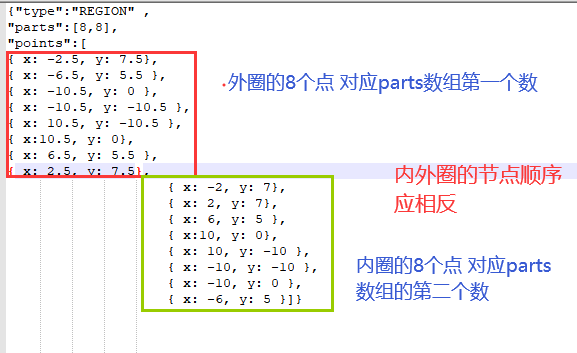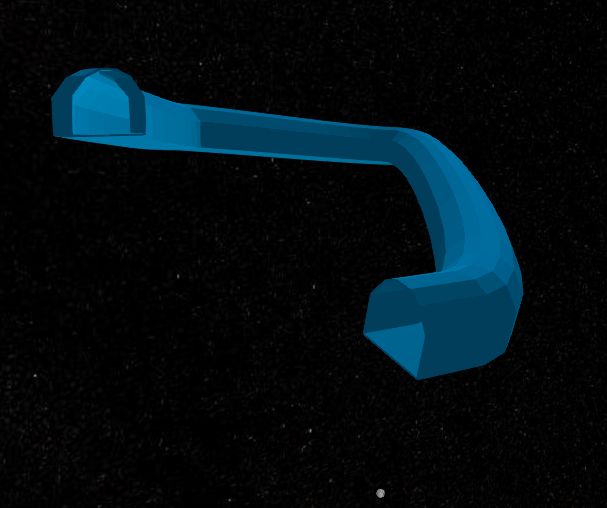使用iServer rest api如何实现构建巷道效果
作者:刘大
背景
在实际生产环境中,特别是在采矿,公路建设项目上,我们往往会接触下图所示的巷道,那么在Web端如何快速通过线数据构建巷道模型呢?下面我们来详细说下
使用方式
第一步: 在iServer发布空间分析服务
第二步:调用 iServer空间分析服务loft放样接口
打开第一步发布的空间分析服务地址,依次点击spatialanalyst–geometry–geometryLoft进入loft放样接口,如下图所示:
由上图看出,我们需要传入待放样三维线对象和横截面对象
而构建巷道的关键之处在于横截面loftRgeion的传入,需要是导洞的形式,导洞具体的写法,我们举一个例子如下:

主要注意两点:
1.parts是个数组,数组的每一项依次取points里面的点串;
2.导洞的内外圈的节点顺序应相反
我们使用postman来构建如下:(请求?后面添加returnContent=true,是设置直接返回模型数据,无需在进行get请求获取资源)

这里,我们就已经构建好了巷道模型,那如何在web端进行呈现捏,这里我们需要使用SuperMap iClient3D for Cesium,11.0.1最新版下载地址(http://support.supermap.com.cn/DownloadCenter/DownloadPage.aspx?id=2246)
最后附上完整代码:
<script type="text/javascript">
function onload(Cesium) {
var viewer = new Cesium.Viewer('cesiumContainer', {
// timeline: true,
infoBox: false,
});
var scene = viewer.scene;
if (!scene.pickPositionSupported) {
alert('不支持深度纹理,可视域分析功能无法使用(无法添加观测)!');
}
//添加体
var s3mInstanceColc;
s3mInstanceColc = new Cesium.S3MInstanceCollection(scene._context);
scene.primitives.add(s3mInstanceColc);
var queryData = JSON.stringify({
"loftRegion": {
"type": "REGION",
"parts": [
8,
8
],
"points": [{
"x": -2.5,
"y": 7.5
},
{
"x": -6.5,
"y": 5.5
},
{
"x": -10.5,
"y": 0
},
{
"x": -10.5,
"y": -10.5
},
{
"x": 10.5,
"y": -10.5
},
{
"x": 10.5,
"y": 0
},
{
"x": 6.5,
"y": 5.5
},
{
"x": 2.5,
"y": 7.5
},
{
"x": -2,
"y": 7
},
{
"x": 2,
"y": 7
},
{
"x": 6,
"y": 5
},
{
"x": 10,
"y": 0
},
{
"x": 10,
"y": -10
},
{
"x": -10,
"y": -10
},
{
"x": -10,
"y": 0
},
{
"x": -6,
"y": 5
}
]
},
"loftLine": {
"type": "LINE3D",
"parts": [8],
"points": [{
"x": 106.647908425709,
"y": 39.53615857754,
"z": 1146.541
},
{
"x": 106.647717466074,
"y": 39.5362496987228,
"z": 1146.541
},
{
"x": 106.64730418415,
"y": 39.5371864323,
"z": 1136.36
},
{
"x": 106.647305608425,
"y": 39.5372768737642,
"z": 1136.36
}
]
},
"chamfer": "50",
"lonlat": "TRUE"
});
$.ajax({
url: "http://172.16.14.25:8090/iserver/services/spatialanalyst-sample/restjsr/spatialanalyst/geometry/3d/loft.json?returnContent=true",
async: true,
data: queryData,
method: "POST"
}).done(function(data) {
if (data.geometry === null) {
return;
}
//添加巷道模型
var u8 = new Uint8Array(data.geometry.model);
var ab = u8.buffer;
s3mInstanceColc.add("resultSkyline", {
position: Cesium.Cartesian3.fromDegrees(data.geometry.position.x, data.geometry.position.y, data.geometry.position
.z),
hpr: new Cesium.HeadingPitchRoll(0, 0, 0),
color: new Cesium.Color(0, 160 / 255, 233 / 255, 0.5)
}, ab, false);
scene.camera.setView({
destination: Cesium.Cartesian3.fromDegrees(data.geometry.position.x, data.geometry.position.y, data.geometry.position
.z),
orientation: {
heading: 1.260586371345841,
pitch: -0.0176030403049122,
roll: 0
}
});
});
}
if (typeof Cesium !== 'undefined') {
window.startupCalled = true;
onload(Cesium);
}
</script>



